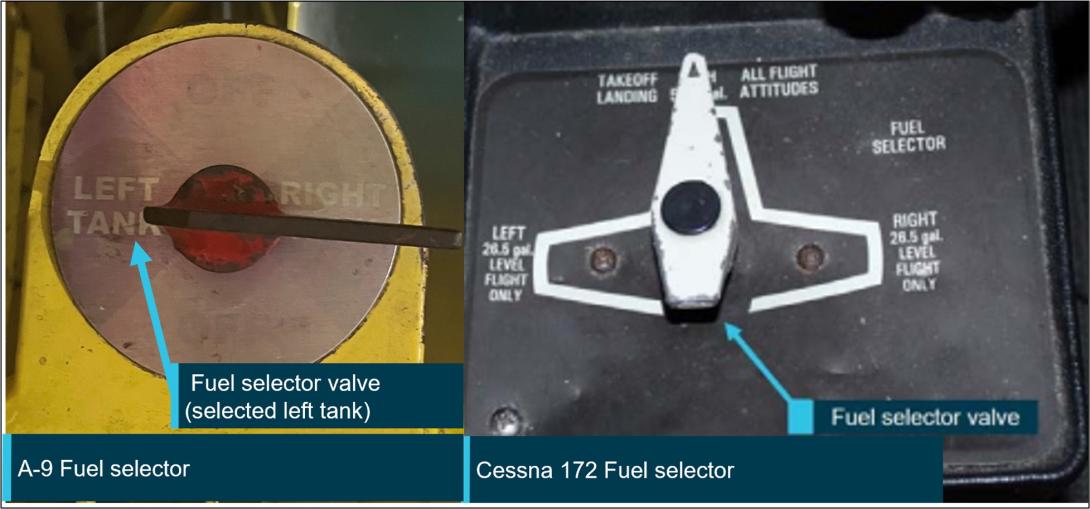What happened
On 29 September 2024, at about 1225 local time, an Intermountain Manufacturing Co A-9A (A-9) was conducting glider towing operations at Lake Keepit aircraft landing area, New South Wales (NSW).
It was reported that, prior to the flight, the aircraft had a minor fuel leak on the left fuel tank drain port. Due to the leak, club policy was to only operate the left fuel tank on the ground, thereby minimising the potential fuel leakage from the left-wing tank.
Figure 1: Intermountain Manufacturing Co A-9A

Source: Photo supplied by operator
Operations commenced at approximately 1030 local time and following the completion of the fourth tow and glider release at about 1224, the aircraft conducted a descent from the north-west of the landing area, intending to join a crosswind[1] for runway 20 (Figure 2).
During a slow left banked turn, on the northern side of the airfield at about 1,500 ft, the engine experienced a sudden loss of power. The pilot attempted to troubleshoot, however was unable to restore normal power to the engine.
The pilot made the decision to close the throttle and conduct a glide approach, broadcasting a PAN-PAN call with intentions to land on runway 14. The engine continued to operate at idle power during the subsequent descent and landing.
The aircraft landed without incident before clearing the runway and taxiing to a suitable parking area. The engine was reported to be operating normally at this time and a normal shutdown was conducted.
Figure 2: Approach path of aircraft

Source: Google earth, annotated by the ATSB
The operator reported that the loss of power in the engine was due to fuel starvation from an incorrect fuel tank selection. The left tank was being operated in flight, with the pilot believing that the fuel was being sourced from the right fuel tank.
The pilot reported having 233 hrs of total time of which 6.9 hrs were on type.
The fuel selector switch in the A-9 is non-traditional to that of some other conventional aircraft types, such as Cessna, Piper, Beechcraft. In those aircraft, the handle is used to indicate the selector (for example, a Cessna 172 is shown in Figure 3, right). In comparison, in the A-9 (Figure 3, left), the fuel selector switch points to the selection so that the longer handle is placed on the opposite side of the tank to which the pilot wishes to select. (There are only left, right and 2 off positions for the selector.)
Figure 3: Fuel selector for the A-9 (left) and as a comparison, a Cessna 172 (right)

Source: Operator photos annotated by the ATSB
Safety message
Accidents involving fuel mismanagement are an ongoing aviation safety concern and pilots are reminded of the importance of understanding an aircraft’s fuel supply system and being familiar and proficient in its use.
Pilots should familiarise themselves with the Civil Aviation Safety Authority publication Advisory Circular AC 91-15 v1.1 Guidelines for aircraft fuel requirements, which provides further guidance for in-flight fuel management.
Practising forced landings from different altitudes under safe conditions can help pilots prepare for an emergency situation, should one arise. Being familiar with emergency checklists and your aircraft’s systems will assist in an emergency when identifying and managing an engine failure.
Examples of other ATSB investigations covering starvation related occurrences include:
- Fuel starvation and ditching involving Piper PA-28, VH-FEY, 15 km north-west of Jandakot Airport, Western Australia, on 20 April 2023 (AO-2023-021).
- Fuel starvation event involving Cessna 310, VH-JQK, near Sunshine Coast Airport, Queensland, on 18 August 2022 (AO-2022-040).
- Fuel starvation involving Cessna 206, 3.5 NM NE of Aldinga, South Australia, on 3 February 2019 (AB-2019-004).
- Fuel starvation and forced landing involving Piper PA-28, VH-BDB, 15 km WSW of Bankstown Airport, New South Wales, on 19 September 2017 (AO-2017-094).
The 2013 ATSB publication AR-2011-112 details accidents involving fuel starvation due to fuel management. Ensuring a constant fuel supply to the engine/s during flight relies on the pilot’s knowledge of the aircraft’s fuel system and being familiar and proficient in its use, especially if the system is different to traditional aircraft.
About this report
Decisions regarding whether to conduct an investigation, and the scope of an investigation, are based on many factors, including the level of safety benefit likely to be obtained from an investigation. For this occurrence, no investigation has been conducted and the ATSB did not verify the accuracy of the information. A brief description has been written using information supplied in the notification and any follow-up information in order to produce a short summary report, and allow for greater industry awareness of potential safety issues and possible safety actions.
[1] When arriving and intending to join the circuit from overhead, descend on the non-active side of the circuit so that the aircraft is established at its circuit altitude as it crosses the runway centreline on crosswind, between midfield and the departure end of the runway.


